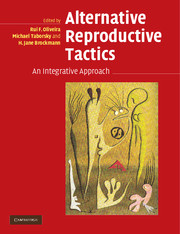Book contents
- Frontmatter
- Contents
- List of contributors
- Preface
- 1 The evolution of alternative reproductive tactics: concepts and questions
- PART I ULTIMATE CAUSES AND ORIGINS OF ALTERNATIVE REPRODUCTIVE TACTICS
- PART II PROXIMATE MECHANISMS OF ALTERNATIVE REPRODUCTIVE TACTICS
- PART III TAXONOMIC REVIEWS OF ALTERNATIVE REPRODUCTIVE TACTICS
- 8 Alternative reproductive tactics in insects
- 9 The expression of crustacean mating strategies
- 10 Alternative reproductive tactics in fish
- 11 Alternative reproductive tactics in amphibians
- 12 Alternative reproductive tactics in reptiles
- 13 Alternative reproductive tactics in birds
- 14 Alternative reproductive tactics in nonprimate male mammals
- 15 Alternative reproductive tactics in primates
- PART IV EMERGING PERSPECTIVES ON ALTERNATIVE REPRODUCTIVE TACTICS
- Index of species
- Subject index
- References
9 - The expression of crustacean mating strategies
Published online by Cambridge University Press: 10 August 2009
- Frontmatter
- Contents
- List of contributors
- Preface
- 1 The evolution of alternative reproductive tactics: concepts and questions
- PART I ULTIMATE CAUSES AND ORIGINS OF ALTERNATIVE REPRODUCTIVE TACTICS
- PART II PROXIMATE MECHANISMS OF ALTERNATIVE REPRODUCTIVE TACTICS
- PART III TAXONOMIC REVIEWS OF ALTERNATIVE REPRODUCTIVE TACTICS
- 8 Alternative reproductive tactics in insects
- 9 The expression of crustacean mating strategies
- 10 Alternative reproductive tactics in fish
- 11 Alternative reproductive tactics in amphibians
- 12 Alternative reproductive tactics in reptiles
- 13 Alternative reproductive tactics in birds
- 14 Alternative reproductive tactics in nonprimate male mammals
- 15 Alternative reproductive tactics in primates
- PART IV EMERGING PERSPECTIVES ON ALTERNATIVE REPRODUCTIVE TACTICS
- Index of species
- Subject index
- References
Summary
CHAPTER SUMMARY
Three fundamental patterns of phenotypic expression exist for alternative mating strategies. These patterns include Mendelian strategies, developmental strategies, and behavioral strategies. Each pattern of expression is revealed by hormonal and neurological factors that regulate the timing and degree to which phenotypic differences appear; however, the nature of each regulatory mechanism depends fundamentally on its underlying mode of inheritance. The genetic architectures underlying such inheritance in turn depend on the circumstances in which mating opportunities arise, including the intensity of selection favoring distinct reproductive morphologies, and the predictability of mating opportunities within individual lifespans. This chapter concerns the nature of this variation and its possible causes, with illustrations from the Crustacea.
INTRODUCTION
Although crustaceans were among the first recorded examples of alternative mating strategies (Orchestia darwinii: Darwin 1874, p. 275; Tanais spp.: Darwin 1874, p. 262), there is currently no synthetic treatment of how such polymorphisms are expressed within this group. The apparent scarcity of reports of male polymorphism among crustaceans is unexpected given the frequency with which sexual selection has been demonstrated within this taxon (Holdich 1968, 1971, Manning 1975, Stein 1976, Thompson and Manning 1981, Knowlton 1980, Shuster 1981, Christy 1983, Hatziolos and Caldwell 1983, reviews in Salmon 1984, Koga et al. 1993). As explained below, when sexual selection occurs, alternative mating strategies are likely to evolve. This chapter provides an evolutionary framework for understanding the expression of alternative mating strategies, with illustrations from the Crustacea (Table 9.1).
- Type
- Chapter
- Information
- Alternative Reproductive TacticsAn Integrative Approach, pp. 224 - 250Publisher: Cambridge University PressPrint publication year: 2008
References
- 20
- Cited by



